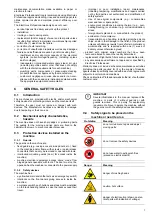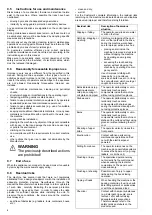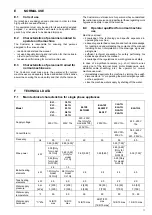
21
• leave the door ajar so that air can circulate inside,
preventing the formation of unpleasant odours.
• periodically air the premises.
NOTE!
After carrying out maintenance make sure the
machine is able to work safely and, in particular,
that the protection and safety devices are efficient.
K.4
Boiler drainage (only for atmospheric
versions)
If the appliance is not to be used for a long time, empty out the
boiler to prevent any malfunction and/or mildew and unpleas-
ant odours.
• Press simultaneously the buttons as shown in the figure.
• A buzzer indicates completion of drainage.
K.5
Machine disposal
At the end of the product’s life cycle, make sure the equipment
is not dispersed in the environment. The equipment must be
disposed of in compliance with current regulations in the
country of use.
All metal parts are in stainless steel (AISI 304) and removable.
Plastic parts are marked with the letters of the material.
The symbol
on the product indicates that this product
should not be treated as domestic waste, but must be correctly
disposed of in order to prevent possible negative consequen-
ces for the environment and the human health.
Regarding the recycling of this product, please contact the
sales agent or dealer of your product, your Customer Care
service or the appropriate waste disposal service.
L
TROUBLESHOOTING
L.1
General troubleshooting
Anomaly
Type of
anomaly
Possible causes
Actions
The dishwasher does not start
Blocking
The dishwasher is not connected
to the main power supply.
Check if the appliance main circuit
breaker is in ON position.
The dishwasher does not
wash well.
Loss of
performance.
No scrape action before putting
dishes in the racks
Scrape dishes before putting them in
the racks.
The wash arms are clogged by
solid food remains. Residual food
has not been removed from
dishes.
Check if the wash jets are clogged by
solid food remains.
The wash arms are not properly
installed.
Check the integrity of the wash arms.
Remove and fit again the wash arms.
The dishes are not correctly
placed in the racks.
Check if the dishes are correctly
placed in the racks.
The dosing of detergent is not
correct.
Call detergent and rinse aid service
centre.
The detergent tank is empty.
Check that there is detergent in the
container and if necessary top it up.
Detergent pump does not work.
Call detergent and rinse aid service
centre.
The wash tank suction filter is dirty.
Clean wash tank suction filter
thoroughly.
Glasses and dishes are not
dried properly.
Loss of
performance.
The container of rinse aid is empty.
Check that there is rinse-aid in the
container and if necessary top it up.
Rinse aid pump does not work.
Call detergent and rinse aid service
centre.
The rinse water temperature is too
low.
Check if the rinse water temperature
is between 82
℃
- 90
℃
.
Call detergent and rinse aid service
centre to set the temperature in
according to the rinse aid
specifications.
Foamy detergent present in the
wash tank.
Check if the dishes were not
immersed in foamy detergent (e.g.
hand wash detergent) before being
put in the dishwasher.
Only use “non-foaming“ products for
professional dishwashers.






































